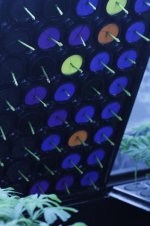martani
Well-known member
Hi guys,
we are just starting with this new project pointing towards the determination of optimal P and N concentrations in the nutrient solution during the flowering stage for a high CBD selection Charlotte Web, grown in RDWC systems (Alien). The experiment will be performed in a 15m^2 containing 6 6-pot RDWC systems, equipped with chiller and UV-C lamp to sterilize the solution. For the entire experiment we are going to perform 2 cycles of 6 treatments each.
Here are some photos of the rooting system: to obtain 36 uniform rooted clones we took 120 cuttings on the 21st of January from 1yr old mother plants and we put them in the rooting system with 40L of demineralized water-based solutions containing 4mL/L of CANNA Rhizotonic, 1 mL/L of Purolyt and phosphoric acid as a pH- until pH=5,6 was reached (for pH and EC readings we use HM-200 HydroMaster). The solution was completely replaced after 2 weeks: rooting times are longer than expected, almost surely due to too low temperatures in the rooting chamber, which range from 10°C at night to a maximum of 18°C (we have a temperature control system, but it's not powerful enough to reach the desired temperature).
PS: we apologize in advance for the huge amount of data we are going to upload, but this thread is meant as a sort of grow/study diary. Since it is our first time with an hydroponic system we'll love to read any comment and/or advice from you. It's going to be hard, but we have high expectations from this project






we are just starting with this new project pointing towards the determination of optimal P and N concentrations in the nutrient solution during the flowering stage for a high CBD selection Charlotte Web, grown in RDWC systems (Alien). The experiment will be performed in a 15m^2 containing 6 6-pot RDWC systems, equipped with chiller and UV-C lamp to sterilize the solution. For the entire experiment we are going to perform 2 cycles of 6 treatments each.
Here are some photos of the rooting system: to obtain 36 uniform rooted clones we took 120 cuttings on the 21st of January from 1yr old mother plants and we put them in the rooting system with 40L of demineralized water-based solutions containing 4mL/L of CANNA Rhizotonic, 1 mL/L of Purolyt and phosphoric acid as a pH- until pH=5,6 was reached (for pH and EC readings we use HM-200 HydroMaster). The solution was completely replaced after 2 weeks: rooting times are longer than expected, almost surely due to too low temperatures in the rooting chamber, which range from 10°C at night to a maximum of 18°C (we have a temperature control system, but it's not powerful enough to reach the desired temperature).
PS: we apologize in advance for the huge amount of data we are going to upload, but this thread is meant as a sort of grow/study diary. Since it is our first time with an hydroponic system we'll love to read any comment and/or advice from you. It's going to be hard, but we have high expectations from this project




